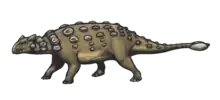| Struthiosaurins Temporal range: Cretaceous, | |
|---|---|
 | |
| Skull of Pawpawsaurus | |
| Scientific classification | |
| Domain: | Eukaryota |
| Kingdom: | Animalia |
| Phylum: | Chordata |
| Clade: | Dinosauria |
| Clade: | †Ornithischia |
| Clade: | †Thyreophora |
| Suborder: | †Ankylosauria |
| Family: | †Nodosauridae |
| Subfamily: | †Nodosaurinae |
| Clade: | †Struthiosaurini Madzia et al., 2021[1] |
| Genera[1] | |
| Synonyms[1] | |
| |
Struthiosaurini (derived from Struthiosaurus, "ostrich reptile") is a clade of nodosaurid ankylosaurs from the Cretaceous of Europe and North America. The group is defined as the largest clade containing Struthiosaurus austriacus, but not Nodosaurus textilis or Panoplosaurus mirus, and was named in 2021 by Madzia and colleagues for the relatively stable group found in many previous analyses. Struthiosaurini includes not only the Late Cretaceous European Struthiosaurus, but also the Early Cretaceous European Europelta, the Late Cretaceous European Hungarosaurus, and Stegopelta and Pawpawsaurus from the mid Cretaceous of North America. The approximately equivalent clade Struthiosaurinae, named in 1923 by Franz Nopcsa was previously used to include European nodosaurids, but was never formally named following the PhyloCode, so Madzia et al. named Struthiosaurini instead, as the group of taxa fell within the clade Nodosaurinae, and having the same -inae suffix on both parent and child taxon could be confusing in future.[1] The 2018 phylogenetic analysis of Rivera-Sylva and colleagues was used as the primary reference for Struthiosaurini by Madzia et al., in addition to the supplemental analyses of Arbour et al. (2016), Brown et al. (2017), and Zheng et al. (2018).[1][2][3][4][5]
| Nodosaurinae |
| |||||||||||||||||||||||||||||||||||||||||||||||||||||||||||||||||||||||||||||||||||||||
A 2023 study refers to this clade as Struthiosauridae due to it being found to form a distinct clade of ankylosaurs.[6]
References
- 1 2 3 4 5 Madzia, D.; Arbour, V.M.; Boyd, C.A.; Farke, A.A.; Cruzado-Caballero, P.; Evans, D.C. (2021). "The phylogenetic nomenclature of ornithischian dinosaurs". PeerJ. 9: e12362. doi:10.7717/peerj.12362. PMC 8667728. PMID 34966571.
- ↑ Rivera-Sylva, H.E.; Frey, E.; Stinnesbeck, W.; Carbot-Chanona, G.; Sanchez-Uribe, I.E.; Guzmán-Gutiérrez, J.R. (2018). "Paleodiversity of Late Cretaceous Ankylosauria from Mexico and their phylogenetic significance". Swiss Journal of Palaeontology. 137: 83–93. doi:10.1007/s13358-018-0153-1. S2CID 134924657.
- ↑ Arbour, V.M.; Zanno, L.E.; Gates, T. (2016). "Ankylosaurian dinosaur palaeoenvironmental associations were influenced by extirpation, sea-level fluctuation, and geodispersal". Palaeogeography, Palaeoclimatology, Palaeoecology. 449: 289–299. Bibcode:2016PPP...449..289A. doi:10.1016/j.palaeo.2016.02.033.
- ↑ Brown, C.M.; Henderson, D.M.; Vinther, J.; Fletcher, I.; Sistiaga, A.; Herrera, J.; Summons, R.E. (2017). "An Exceptionally Preserved Three-Dimensional Armored Dinosaur Reveals Insights into Coloration and Cretaceous Predator-Prey Dynamics". Current Biology. 27 (16): 2514–2521. doi:10.1016/j.cub.2017.06.071. PMID 28781051. S2CID 5182644.
- ↑ Zheng, W.; Jin, X.; Azuma, Y.; Wang, Q.; Miyata, K.; Xu, X. (2018). "The most basal ankylosaurine dinosaur from the Albian–Cenomanian of China, with implications for the evolution of the tail club". Scientific Reports. 8 (1): 3711. Bibcode:2018NatSR...8.3711Z. doi:10.1038/s41598-018-21924-7. PMC 5829254. PMID 29487376.
- ↑ Raven, T. J.; Barrett, P. M.; Joyce, C. B.; Maidment, S. C. R. (2023). "The phylogenetic relationships and evolutionary history of the armoured dinosaurs (Ornithischia: Thyreophora)". Journal of Systematic Palaeontology. 21 (1). 2205433. doi:10.1080/14772019.2023.2205433.

